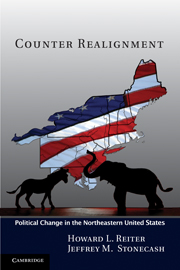Book contents
- Frontmatter
- Contents
- List of Figures
- List of Tables
- Preface
- Acknowledgments
- Postscript: Democratic Fortunes in the Northeast in 2010
- 1 Party Strategies and Transition in the Northeast
- 2 Party Pursuits and the Sources of Change
- 3 The First Republican Losses
- 4 Searching for a Majority, the Rise of Conservatives, and Second Losses
- 5 Interpreting the Goldwater Election and Pursuing the South
- 6 Social Change, Party Response, and Further Republican Losses
- 7 National Parties and the Position of the Northeast
- 8 The Process of Change and the Future
- Index
Postscript: Democratic Fortunes in the Northeast in 2010
Published online by Cambridge University Press: 05 June 2012
- Frontmatter
- Contents
- List of Figures
- List of Tables
- Preface
- Acknowledgments
- Postscript: Democratic Fortunes in the Northeast in 2010
- 1 Party Strategies and Transition in the Northeast
- 2 Party Pursuits and the Sources of Change
- 3 The First Republican Losses
- 4 Searching for a Majority, the Rise of Conservatives, and Second Losses
- 5 Interpreting the Goldwater Election and Pursuing the South
- 6 Social Change, Party Response, and Further Republican Losses
- 7 National Parties and the Position of the Northeast
- 8 The Process of Change and the Future
- Index
Summary
The years 2000 to 2008 witnessed a clear trend in the Northeast toward the Democratic Party. The elections of 2010 provided an indication of whether that trend could survive a national move to the Republicans. Republicans made some gains in the Northeast, but those elections also served to increase the region's difference from the rest of the nation because Republicans made much greater gains outside the Northeast. Although the rest of the nation moved decisively Republican in 2010, the Northeast remained heavily Democratic – despite the effect of Tea Party candidates who focused on the economic and budget issues that had been more popular in the Northeast than the social issues that Republicans often promoted.
The situation over the course of the decade is seen in the accompanying table. When the decade began, the Northeast was more supportive of Democrats. Democratic presidential candidates won a higher percentage of the vote in the Northeast, and Democrats won a higher percentage of Senate and House seats. By 2008, Democrats were doing better within the region for all offices. The 2010 national political conditions were very negative for Democrats. A strong majority saw the country as headed in the wrong direction, there was little national job growth, and the recently passed health care legislation was vehemently opposed by conservatives, who thought that the national government was becoming too big.
- Type
- Chapter
- Information
- Counter RealignmentPolitical Change in the Northeastern United States, pp. xvii - xxPublisher: Cambridge University PressPrint publication year: 2011



